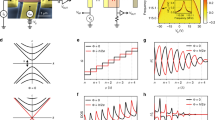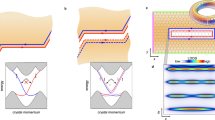Abstract
Joule energy loss due to resistive heating is omnipresent in today’s electronic devices whereas quantum-mechanical dissipation is largely unexplored. Here, we experimentally observe a suppression of the Joule dissipation in Bi2Te3 due to topologically protected surface states. Instead, a different type of dissipation mechanism is observed by pendulum atomic force microscopy, which is related to single-electron tunnelling resonances into image potential states that are slightly above the Bi2Te3 surface. The application of a magnetic field leads to the breakdown of the topological protection of the surface states and restores the expected Joule dissipation process. Nanomechanical energy dissipation experienced by the cantilever of the pendulum atomic force microscope provides a rich source of information on the dissipative nature of the quantum-tunnelling phenomena on the topological insulator surface, with implications for coupling a mechanical oscillator to the generic quantum material.
This is a preview of subscription content, access via your institution
Access options
Access Nature and 54 other Nature Portfolio journals
Get Nature+, our best-value online-access subscription
$29.99 / 30 days
cancel any time
Subscribe to this journal
Receive 12 print issues and online access
$259.00 per year
only $21.58 per issue
Buy this article
- Purchase on Springer Link
- Instant access to full article PDF
Prices may be subject to local taxes which are calculated during checkout






Similar content being viewed by others
Data availability
The data that support the findings of this study are available from the corresponding authors on reasonable request.
References
Chen, Y. L. et al. Experimental realization of a three-dimensional topological insulator, Bi2Te3. Science 325, 178–181 (2009).
Hasan, M. Z. & Kane, C. L. Colloquium: Topological insulators. Rev. Mod. Phys. 82, 3045–3067 (2010).
Seo, J. et al. Transmission of topological surface states through surface barriers. Nature 466, 343–346 (2010).
Zhang, T. et al. Experimental demonstration of topological surface states protected by time-reversal symmetry. Phys. Rev. Lett. 103, 266803 (2009).
He, H.-T. et al. Impurity effect on weak antilocalization in the topological insulator Bi2Te3. Phys. Rev. Lett. 106, 166805 (2011).
Straub, D. & Himpsel, F. J. Spectroscopy of image-potential states with inverse photoemission. Phys. Rev. B 33, 2256–2262 (1986).
Dose, V. Image potential surface states. Phys. Scr. 36, 669–672 (1987).
Echenique, P. & Uranga, M. Image potential states at surfaces. Surf. Sci. 247, 125–132 (1991).
Berthold, W. et al. Momentum-resolved lifetimes of image-potential states on Cu(100). et al. Phys. Rev. Lett. 88, 056805 (2002).
Wahl, P., Schneider, M. A., Diekhöner, L., Vogelgesang, R. & Kern, K. Quantum coherence of image-potential states. Phys. Rev. Lett. 91, 106802 (2003).
Schouteden, K. & Van Haesendonck, C. Quantum confinement of hot image-potential state electrons. Phys. Rev. Lett. 103, 266805 (2009).
Niesner, D. & Fauster, T. Image-potential states and work function of graphene. J. Phys. Condens. Matter 26, 393001 (2014).
Sobota, J. A. et al. Ultrafast optical excitation of a persistent surface-state population in the topological insulator Bi2Se3. Phys. Rev. Lett. 108, 117403 (2012).
Sobota, J. A. et al. Direct optical coupling to an unoccupied Dirac surface state in the topological insulator Bi2Se3. Phys. Rev. Lett. 111, 136802 (2013).
Niesner, D. et al. Unoccupied topological states on bismuth chalcogenides. Phys. Rev. B 86, 205403 (2012).
Niesner, D. et al. Bulk and surface electron dynamics in a p-type topological insulator SnSb2Te4. Phys. Rev. B 89, 081404 (2014).
Niesner, D. et al. Electron dynamics of unoccupied states in topological insulators. J. Electron Spectrosc. Relat. Phenom. 195, 258–262 (2014).
Gundlach, K. H. Zur berechnung des tunnelstroms durch eine trapezförmige potentialstufe. Solid State Electron. 9, 949–957 (1966).
Höfer, U. et al. Time-resolved coherent photoelectron spectroscopy of quantized electronic states on metal surfaces. Science 277, 1480–1482 (1997).
Kisiel, M. et al. Suppression of electronic friction on Nb films in the superconducting state. Nat. Mater. 10, 119–122 (2011).
Langer, M. et al. Giant frictional dissipation peaks and charge-density-wave slips at the NbSe2 surface. Nat. Mater. 13, 173–177 (2013).
Kisiel, M. et al. Noncontact atomic force microscope dissipation reveals a central peak of SrTiO3 structural phase transition. Phys. Rev. Lett. 115, 046101 (2015).
Stipe, B. C., Mamin, H. J., Stowe, T. D., Kenny, T. W. & Rugar, D. Noncontact friction and force fluctuations between closely spaced bodies. Phys. Rev. Lett. 87, 096801 (2001).
Volokitin, A. I. & Persson, B. N. J. Near-field radiative heat transfer and noncontact friction. Rev. Mod. Phys. 79, 1291–1329 (2007).
Neupane, M. et al. Topological surface states and Dirac point tuning in ternary topological insulators. Phys. Rev. B 85, 235406 (2012).
Miyamoto, K. et al. Topological surface states with persistent high spin polarization across the Dirac point in Bi2Te2Se and Bi2Se2T. Phys. Rev. Lett. 109, 166802 (2012).
Schouteden, K. et al. Moiré superlattices at the topological insulator Bi2Te3. Sci. Rep. 6, 20278 (2016).
Pivetta, M., Patthey, F., Stengel, M., Baldereschi, A. & Schneider, W. D. Local work function moiré pattern on ultrathin ionic films: NaCl on Ag(100). Phys. Rev. B 72, 115404 (2005).
Bose, S. et al. Image potential states as a quantum probe of graphene interfaces. New J. Phys. 12, 023028 (2010).
Volokitin, A. I., Persson, B. N. J. & Ueba, H. Enhancement of noncontact friction between closely spaced bodies by two-dimensional systems. Phys. Rev. B 73, 165423 (2006).
Cockins, L. et al. Energy levels of few-electron quantum dots imaged and characterized by atomic force microscopy. Proc. Natl Acad. Sci. USA 107, 9496–9501 (2010).
Kisiel, M. et al. Mechanical dissipation from charge and spin transitions in oxygen-deficient SrTiO3 surfaces. Nat. Commun. 9, 2946 (2018).
Stomp, R. et al. Detection of single-electron charging in an individual InAs quantum dot by noncontact atomic-force microscopy. Phys. Rev. Lett. 94, 056802 (2005).
Paulsson, M., Zahid, F. & Datta, S. Resistance of a Molecule 426 (CRC Press, 2002).
Volokitin, A. I. & Persson, B. N. J. in Fundamentals of Friction and Wear on the Nanoscale (eds Gnecco, E. & Meyer, E.) 426 (Springer, 2007).
Sarid, D. Scanning Force Microscopy with Applications to Electric, Magnetic and Atomic Forces (Oxford Univ. Press, 1991).
Sessi, P. et al. Signatures of Dirac fermion-mediated magnetic order. Nat. Commun. 5, 5349 (2014).
Olsen, J. L. Electron Transport in Metals (Interscience, 1962).
Fatayer, S. et al. Controlled fragmentation of single molecules with atomic force microscopy by employing doubly charged states. Phys. Rev. Lett. 121, 226101 (2018).
Cleveland, J. P., Anczykowski, B., Schmid, A. E. & Elings, V. B. Energy dissipation in tapping-mode atomic force microscopy. Appl. Phys. Lett. 72, 2613–2615 (1998).
Acknowledgements
We acknowledge fruitful discussions with E. Tosatti. The Basel group acknowledges financial support from the Swiss National Science Foundation (SNSF), the COST action Project MP1303, the SINERGIA Project CRSII2 136287/1, the European Union’s Horizon 2020 research and innovation programme (ERC Advanced Grant no. 834402) and the Swiss Nanoscience Institute (project no. P1301). O.G. acknowledges financial support from TÜBİTAK project 114F036 and the COST action project MP1303 (TÜBİTAK112T818).
Author information
Authors and Affiliations
Contributions
O.G. proposed the experiment. D.Y., M.K. and U.G. performed the experiments. E.M. coordinated the project. All authors discussed the results and contributed to the preparation of the paper.
Corresponding authors
Ethics declarations
Competing interests
The authors declare no competing interests.
Additional information
Publisher’s note Springer Nature remains neutral with regard to jurisdictional claims in published maps and institutional affiliations.
Supplementary information
Supplementary Information
Supplementary Notes 1–4 and Figs. 1–8.
Rights and permissions
About this article
Cite this article
Yildiz, D., Kisiel, M., Gysin, U. et al. Mechanical dissipation via image potential states on a topological insulator surface. Nat. Mater. 18, 1201–1206 (2019). https://doi.org/10.1038/s41563-019-0492-3
Received:
Accepted:
Published:
Issue Date:
DOI: https://doi.org/10.1038/s41563-019-0492-3
This article is cited by
-
Energy dissipation on magic angle twisted bilayer graphene
Communications Physics (2023)
-
The mechanisms and applications of friction energy dissipation
Friction (2023)
-
Quantum methods
Nature Materials (2020)
-
Thickness-dependent frictional behavior of topological insulator Bi2Se3 nanoplates
Applied Physics A (2020)
-
Shrewd detectives find a dissipation channel
Nature Materials (2019)



